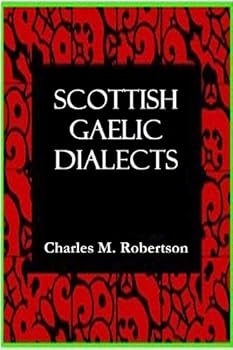

Contents:
1. INTRODUCTORY
2. SHORT VOWELS BEFORE LONG LIQUIDS
3. VOWELS UNALTERED
4. VOWELS LENGTHENED
5. VOWELS DIPHTHONGISED
6. LONG NARROW VOWELS
7. VOWELS IN UNACCENTED SYLLABLES
8. FINAL VOWELS
9. NASALISED VOWELS
10. SVARABHAKTI VOWEL BETWEEN TWO WORDS
11. SVARABHAKTI INTERNALLY
12. METATHESIS OF VOWEL AND CONSONANT
13. LIQUID CHANGES
14. GUTTURALS
15. DENTALS
16. ASSIMILATION
17. ASSIMILATION EXTERNALLY
18. ASPIRATION
19. ECLIPSIS
20. METATHESIS
***
An excerpt from the beginning:
1. INTRODUCTORY
The importance of a thorough and systematic investigation of our Gaelic dialects was urged by Professor Mackinnon in a paper read before the Gaelic Society of Inverness exactly twenty years ago. Before that time there were scattered remarks on dialectical peculiarities in grammars and dictionaries and other publications, and a recognition of two or, on the part of some authorities, of three main dialects. The Rev. John Forbes in his grammar tries to distinguish three dialects—a Northern, an Interior, and a Southern. Mr. James Munro, whose grammar contains not a few accurate observations of peculiarities and variations, distinguishes on occasion the mid Highlands from Ross and Sutherland, but, in general, classing the mid Highlands and the far north together, he recognises but the two divisions of North Highland and West Highland. Mr. Neil MacAlpine, from whose dictionary most of the peculiarities of Islay and mid Argyll dialect can be gathered, recognises in practice, if he does not formally state, the twofold division. The division into three dialects, in effect, is a division into Northern and Southern (or Western) Gaelic, with a further division of the former into two sub-dialects. The differences upon which the sub-division has been based are not on a par with the broad distinctions between Southern and Northern Gaelic. An equally good case could be made out for sub-dividing Southern Gaelic which has in Arran, Kintyre, and Islay Irish and Manx affinities not found further north. Nothing is gained by going beyond two divisions and stopping at three. The division into two main dialects is clear, familiar, and useful, while, as Professor Mackinnon holds in the paper referred to, ‘On the Dialects of Scottish Gaelic’: ‘The threefold divisions cannot, without considerable confusion, be maintained,’ and again, ‘It would perhaps be as easy to distinguish thirteen dialects as three.’ How many well-defined dialects underlie the two main divisions can only be determined by a systematic investigation of the spoken language in every district of Gaeldom. As a result of Professor Mackinnon’s endeavours to direct attention to the matter by that paper and in his lectures to his students, something has been done during those twenty years. First came a paper by the Rev. Adam Gunn, M.A., on the dialects of the Reay country, which is a model of what such papers ought to be. Then the dialect of Badenoch was dealt by Dr. MacBain. The Rev. John Kennedy, who was third in the field with a paper on Arran Gaelic, wrote of a dialect other than his native one, and was the first to do so. These papers and others on the dialects of Arran, Perthshire, Skye, the west of Ross-shire and Sutherland, appear in the Transactions of the Gaelic Society of Inverness (vols. xv., xviii., xx. et seq. Professor Mackinnon’s paper is in vol. xii.). Mr. Gunn has a later and fuller paper on his dialect in the Celtic Monthly (vol. vi.). The Rev. Dr. Henderson also has been writing comprehensively and thoroughly on the dialects generally of late in the Zeitschrift fьr Celtische Philologie. All this work (which, it may be remarked, with the exception of the papers by Dr. MacBain and Mr. Kennedy, has been done by students trained by Professor Mackinnon) affords material for determining the characteristics and limits, to some extent at least, of the local dialects into which our Gaelic divides itself. The vowels claim attention first and show the most far-reaching...
DOWNLOAD SCOTTISH GAELIC DIALECTS (THE CELTIC REVIEW) - CHARLES M. ROBERTSON
Hiç yorum yok:
Yorum Gönder